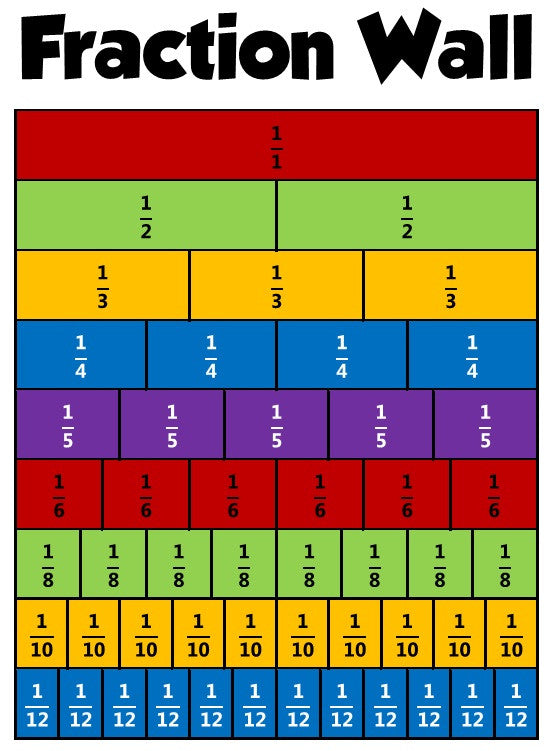
Why are fractions so difficult to learn?
As many teachers and parents know, learning the various fraction operations can be difficult for many children. It's not the concept of a fraction that is difficult - it is the various operations: addition, subtraction, multiplication, division, comparing, simplifying, etc. of fractions
And the simple reason why learning those operations proves difficult for many students is the way they are typically taught. Just look at the amount of rules there are to learn about fractions!
| 1. Fraction addition - common denominators | Add the numerators, and use the common denominator |
| 2. Fraction addition - different denominators | First find a common denominator by taking the least common multiple of the denominators. Then convert all the addends to have this common denominator. Then add using the rule number 1. |
| 3. Finding equivalent fractions | Multiply both the numerator and denominator by a same number. |
| 4. Convert a mixed number to a fraction | Multiply the whole number part by the denominator and add the numerator to get the numerator. Use the common denominator as in the fractional part of the mixed number. |
| 5. Convert an improper fraction to a mixed number | Divide the numerator by the denominator to get the whole number part. The remainder will be the numerator of the fractional part. Denominator is the same. |
| 6. Simplifying fractions | Find the (greatest) common divisor of the numerator and denominator, and divide both by it. |
| 7. Fraction multiplication | Multiply the numerators and the denominators. |
| 8. Fraction division | Find the reciprocal of the divisor, and multiply by it. |
| 9. Comparing fractions | Convert the fractions so they have a common denominator. Then compare the numerators. |
| 10. Convert fractions to decimals | Divide using long division or a calculator. |
If students simply try to memorize these rules without knowing where they came from, the rules will probably seem like a meaningless jungle. They probably won't seem to connect with anything about the operation, but instead work like "magic": you multiply, divide, and do various things with the numerators and denominators to come up with the answer.
Students can then become blind followers of the rules, tossing numbers here and there, calculating this and that - and getting answers without having any idea if they are reasonable or not. Besides, it is quite easy to forget these rules - especially after 5-10 years.
The solution: manipulatives and visual models
Instead of merely presenting a rule, a better way is to use visual models or manipulatives during the study of fraction arithmetic. That way fractions become something concrete to the student, and not just a number on top of another without a meaning. The student will be able to estimate the answer before calculating, evaluate the reasonableness of the final answer, and perform many of the simplest operations mentally without knowingly applying any "rule."
Now, typical textbooks DO show visual models for fractions, and they DO show one or two examples of how a certain rule connects with a picture. But that is not enough! We need to have children solve lots of problems using either visual models or fraction manipulatives. Another way is to ask them to DRAW fraction pictures for the problems. That way the students will form a mental visual model and can think through the pictures.
If you think through pictures, you will easily see the need for multiplying or dividing both the numerator and denominator by the same number. But before voicing that rule, it is better that children get lots of 'hands-on' experiences with fraction pictures they draw themselves. They can even have fun splitting the pieces further or conversely merging pieces together. They may find the rule themselves even - and it will make sense. If they forget the rule later, they can always fall back to thinking about splitting the pieces and re-discover it.
The teacher can show how the pieces in the fractions need to be split further so that they all are the same kind of pieces—and then you can add. At first (say in 4th grade), you don't need to discuss the "least common denominator". You can simply use pictures or manipulatives.
Then, the children will add unlike fractions using manipulatives or by drawing pictures. After a while, some students might discover the rule about the common denominator, or what kind of pieces the fractions will need split into. In any case, they will certainly remember the rule better when they have been able to verify it themselves with numerous visual examples.
I'm not saying that the rules are not needed - because they are. You cannot get through algebra without knowing the actual rules for fraction operations. But by using visual models extensively in the beginning stages, the rules will make more sense, and if 10 years later the student has forgotten the rules, he should still able to "do the math" with the pictures in his mind, and not consider fractions as something he just "cannot do".
Therefore we have brought in the fraction workbook & manipulatives set to help children grasp the foundation of fractions. With a good foundation in fractions, learning decimals and percentages will be a lot easier.
Click here to find out more about our fraction set


